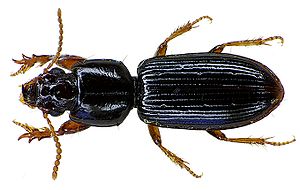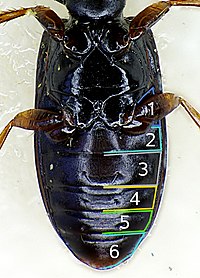Common tombstone runner
| Common tombstone runner | ||||||||||||
|---|---|---|---|---|---|---|---|---|---|---|---|---|

Common grave spurs ( Clivina fossor ) |
||||||||||||
| Systematics | ||||||||||||
|
||||||||||||
| Scientific name | ||||||||||||
| Clivina fossor | ||||||||||||
| ( Linnaeus , 1758) |
| Pictures of the beetle | |

|
|
| Fig. 1: Edge of the pronotum | |

|
|
| Fig. 2: Edge of the elytra | Fig. 5: Seen from the front |
| Fig. 3: side view | Fig. 6: Bottom |
|
Fig. 4: Underside, numbered abdominal sternite on the right |
|
| Fig. 7: Mid-breast seen from the side, copy on the right partially colored ocher: pronotum blue: wing covers gray: thighs of the middle leg green: border of the mid-hip cavity red: epimer of the mid-breast |
|
The common burial spur ( Clivina fossor ), also called the black-brown finger beetle, is a beetle from the family of ground beetles (Carabidae). There are many similar beetles whose front legs are also transformed into grave legs .
features
The species reaches a body length of five to 6.5 millimeters and is therefore slightly larger on average than the very similar Clivina contracta . Both are missing the dotted, furrowed, deepened "Y" on both sides on the base half of the pronotum , which characterizes the third Central European species of the genus, Clivina ypsilon . The species of the genus Clivina differ from the species of the similar genus Dyschirius in that the sides of the pronotum are bordered down to the base (Fig. 1) and that the throat of the outer edge of the elytra has an uninterrupted series of rough points (Fig. 2).
The chunky head is longer than it is wide and narrower than the pronotum. He has no central furrow, but a dimple on the forehead. Two lateral longitudinal furrows are set off like a keel. The compound eyes are only slightly curved. Above the eye there is a bristle point with a long bristle in the middle and in the back (two supraorbital bristles, clearly visible in Fig. 5). The eleven-part antennae are pearl-shaped and widen slightly towards the outside. They are hairy from the third limb (Fig. 1, left). The antennae root is covered by a lateral widening of the forehead (Fig. 1, left; Fig. 5). The mouthparts point forward, the upper lip is whole. The mandibles barely protrude and at most have a hint of a tooth. The end link of the jaw probe is long, spindle-shaped and hardly thicker than the penultimate link.
The pronotum is square and longer than it is wide, and slightly narrowed towards the front. In each corner there is a bristle point from which a long bristle emerges. It is rounded at the front corners, truncated at an angle and narrowed like a neck. It has irregular engravings, which, however, do not form symmetrical "Y" drawings at the base.
The wing covers are long, cylindrical and only flattened on the back. Together they are slightly wider than the pronotum and about 1.9 times as long as they are wide. They are less parallel than with Clivina ypsilon . At the back they are rounded together. They are striped with dots, in the third interval there are four pore points with bristles (clearly visible in Fig. 3 at high resolution). The outer edge of the elytra is set off by a shallow throat in which there are rough points along the entire length (Fig. 2).
In contrast to the pitch-brown body and the wing covers, the antennae and legs are reddish. The tarsi are all five-limbed and less developed than common in ground beetles. Compared to the splints, they are slender, especially on the front legs (Fig. 3, Fig. 6). The front end of the front rails is drawn out laterally to form a long, outwardly curved blunt spike that protrudes over the first phalanx. In addition, the front rails are wider and have two more teeth on the side. The tooth closer to the body can be weak. The animal digs holes or passages in loose soil with these grave legs. On the inside, the front rails have a clearly pronounced plaster notch.
Occurrence
The species is widespread in Europe. It also occurs Holarctic in Asia, North America and North Africa. It is moisture-loving, but otherwise not very picky about its habitat. The beetles are found on banks, in meadows and fields, on arable weeds, in moors, etc. from the plains to the mountains. Since the imagines are able to fly, you can meet them also to temporary wet soils. The species is found regularly when investigating cultivated areas.
Way of life
The larvae of the species live underground and are blind. The beetles also live in self-dug corridors, on the surface under stones and woods or under the surface of the earth. Clivina fossor prefers larvae and pupae for its food intake, e.g. B. from the rapeseed beetle ( Meligethes aeneus ). As a partially herbivorous species, the species occasionally also causes damage to young sugar beet plants. The pests on sugar beet seedlings can lead to withering and death of the beet plants. The species overwinters as an imago.
swell
Individual evidence
- ↑ Werner Jossi et al .: Influence of management on the beneficial fauna AGRARForschung 11 (3) pp. 98–103, 2004
- ↑ H. Mielke, B. Schöber-Butin: 'Plant protection in renewable raw materials' Mitt.Biol.Bundesanstal.Land-Forstwirtsch. 391, 2002 p. 28
literature
- Heinz Joy, Karl Wilhelm Harde, Gustav Adolf Lohse: The beetles of Central Europe . tape 2 . Adephaga 1. Elsevier, Spektrum, Akad. Verl., Munich 1976, ISBN 3-87263-025-3 .
- Ekkehard Wachmann , Ralph Platen, Dieter Barndt: Ground beetles - observation, way of life . 1st edition. Naturbuch-Verlag, Augsburg 1995, ISBN 3-89440-125-7 .
- Gustav Jäger (Ed.): CG Calwer 's Käferbuch . K. Thienemanns, Stuttgart 1876, 3rd edition




